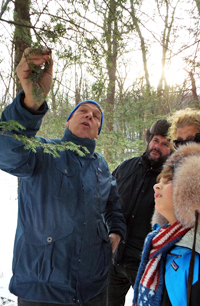

A fresh powder covered the ground as 20 people gathered in Black Rock Forest on a Saturday afternoon for a winter walk. The excursion was led by Dr. William Schuster, executive director of the Black Rock Forest Consortium.
During the 90-minute, mile-long walk to the Upper Reservoir and back, Schuster highlighted five of the conifers, or cone-bearing trees in the forest, and commented on how they would react to global warming.
Of the over 60 species of trees in the forest, 10 of them are conifers. Schuster said the conifers were among the first trees to develop evolutionarily. During a time when there weren’t many animals on the planet, these trees would disperse their light, winged seeds through the wind. As animals become more prevalent, these trees developed other means of seed dispersal, using these animals as a secondary option.
Conifers have a conical shape with branches that bend down so they are less likely to snap from the weight of snow.
The Eastern Red Cedar is extremely successful and widespread, covering most of the eastern United States into the midwest. It has rose-colored wood inside and is pest and rot-resistant. The wood also has a wonderful, long-lasting odor. Its cone are the small berries which resemble blueberries in color. They taste bitter and are used to make gin. Schuster said the cedar is adapted to poor soil and can survive in warm weather conditions, making it a good candidate to survive a climate change.
The Eastern Hemlock has had a presence on Earth for more than 5,000 years, however, it likely wouldn’t survive global warming. These trees are more adapted to the cold climates of the north. In a 1985 survey of the trees in Black Rock Forest, the Hemlock was the only conifer to hit one percent. There used to be 100 acres of healthy Hemlock trees until the 1990s when the Hemlock Wooly Adelgid started feeding on the trees and killing them. The presence of these insects can be identified by the small, cottony puffs on the underside of the needles. A single tuft can have 25 or more insect larva. Schuster said the tree’s demise is noticeable by looking at the forest’s canopy. If the trees are healthy, very little sunlight should be able to reach the forest floor. The worst part of the infestation has passed as birds and beetles are recognizing the insect as a food source.
The Red Pine has long needles and high branches. While the pine is a native species, it was not common to the forest until it was planted. These trees are found in the colder climates of Canada and the Great Lakes states. Fifty years from now, there might not be anymore Red Pines.
White Pines are identifiable by their clusters of long, thin needles. The age of the tree is determined by the number of rows of branches. A new row grows each year. They are well distributed up and down the eastern United States and have proven to do well with climate change. After 20 to 25 years of growth, these conifers will develop big, long cones. When Central Hudson installed a gas line near the Upper Reservoir, a donation was made to the consortium for revegatation.
To complete the hike, Schuster saved the best for last. On the far side of the reservoir is a picturesque cluster of young and old Norway Spruce. Best known as the classic Christmas tree, the Norway Spruce has long, heavy cones which cause the branches to droop. The drooping branches make a good shelter for animals and humans. The Norway Spruce is not native to the forest, but was planted in the 20th century on the Barton Farms property. Norway spruce does best in cool climates like its natural range in northern Europe. While it is a very hardy tree, if the future features extended periods that are hotter than it is now, I expect that it will decline in our area, said Schuster.
Once the walk was over, Schuster invited all those interested back to his house for hot chocolate and cider.
